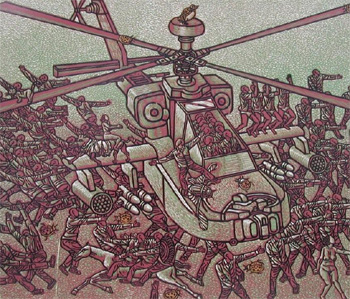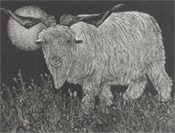 |
| Zhang Minjie, Chinese, 5 Games I (Helicopter) 2001, Color woodcut, on loan by the artist |
Through August 3, 2008
Printmaking was invented in China. During the Tang period (617- 907 CE), Buddhist images carved in reliefs in stone and wood were printed on paper and fabric. However, printing and illustration in China were aimed at a comparatively small and sophisticated audience. The graphic arts reached an apogee of refinement during the Ming dynasty (1368-1644), but there was no printing industry to bridge the gulf between the fine art and folk traditions. It was a different situation in Japan and Europe, where printmaking developed as an economical way to communicate without words to large, widely dispersed audiences.
In the 1980s, when sweeping political and cultural changes came to China, a new practice of fine printmaking began to emerge for new domestic and international audiences. This work merged Chinese academic painting styles and longstanding craft traditions, with western-style limited edition artists' prints. Some of the prints employ the clear, heroic naturalism of Social Realism to convey themes of social and political propaganda. Others employ a folksier voice to criticize life under Communism. Many reflect the aesthetics of folk painting and design ideas adapted from folk arts like papercuts and naive craft objects. All these streams flow together into a thriving new tradition of Chinese printmaking. Among the artists whose work will be included are Cong Zhiyuang, Dong Jiansheng, Li Yangpeng, WangWei, and Zhang Minjie. Inky Tributaries presents a selection of prints from contemporary China that reflects the changing face of the China under different political climates over the last thirty years. They are works of art that project a fascinating glimpse of far-away cultures with surprising virtuosity and elegance.
Select Images from the Exhibition


 Sign up for WAM eNews
Sign up for WAM eNews